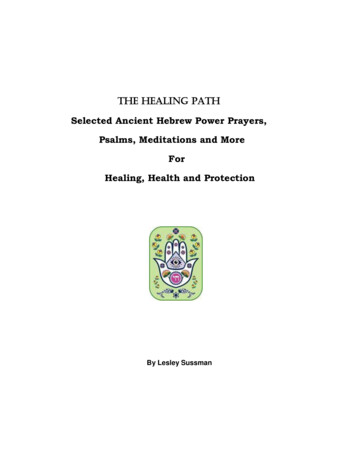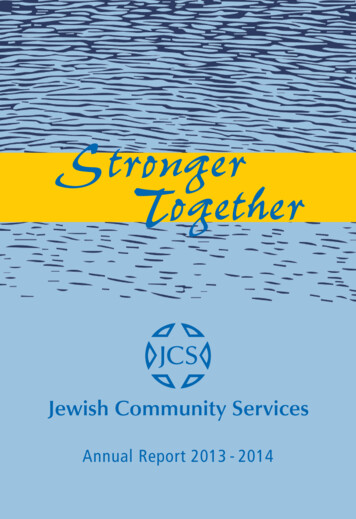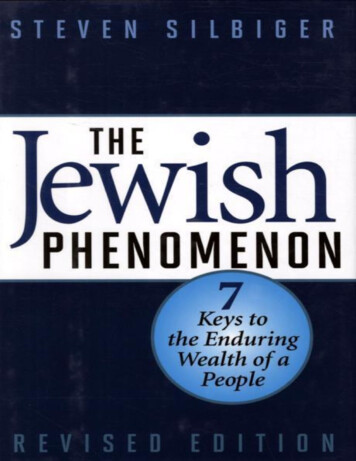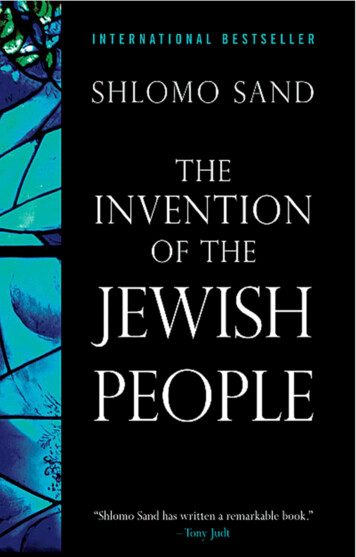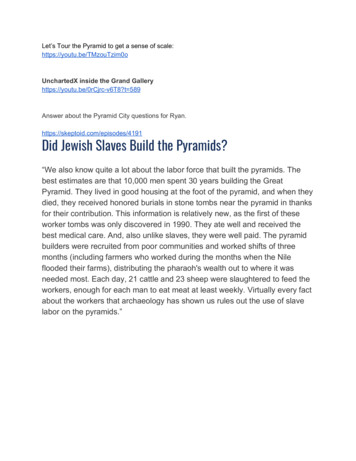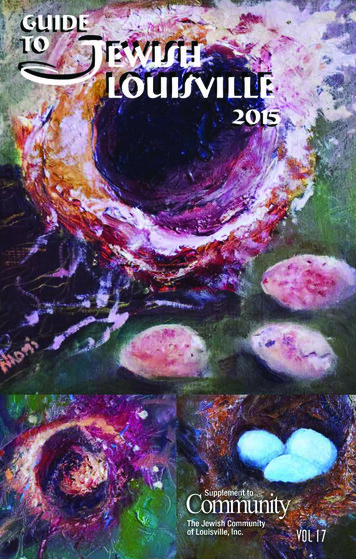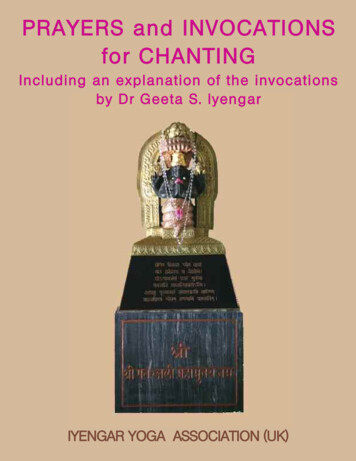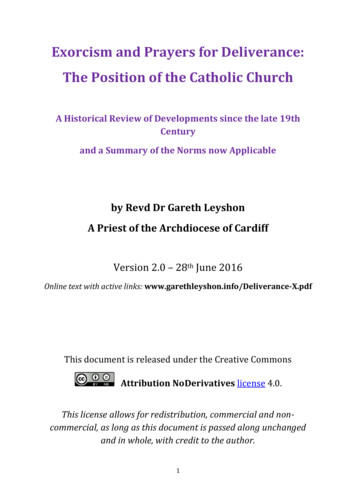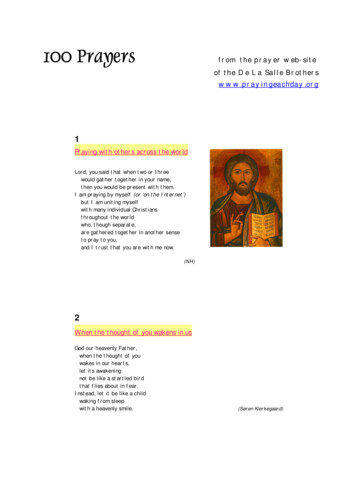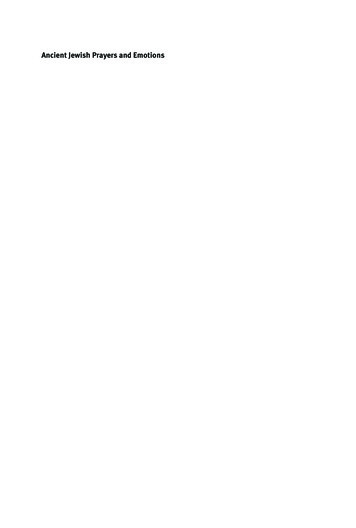
Transcription
Ancient Jewish Prayers and Emotions
Deuterocanonical andCognate Literature StudiesEdited byFriedrich V. Reiterer, Beate Ego and Tobias NicklasVolume 26
Ancient Jewish Prayersand EmotionsEmotions associated with Jewish prayerin and around the Second Temple periodEdited byStefan C. Reif and Renate Egger-Wenzel
An electronic version of this book is freely available, thanks to the support of libraries working with Knowledge Unlatched. KU is a collaborative initiative designed tomake high quality books Open Access. More information about the initiative can befound at www.knowledgeunlatched.orgThis work is licensed under the Creative Commons Attribution-NonCommercial-NoDerivs 4.0 License.For details go to ISBN 978-3-11-037429-2e-ISBN (PDF) 978-3-11-036908-3e-ISBN (EPUB) 978-3-11-038608-0ISSN 1865-1666Library of Congress Cataloging-in-Publication DataA CIP catalog record for this book has been applied for at the Library of Congress.Bibliographic information published by the Deutsche NationalbibliothekThe Deutsche Nationalbibliothek lists this publication in the Deutschen Nationalbibliografie;detailed bibliographic data are available on the Internet at http://dnb.dnb.de. 2015 Walter de Gruyter GmbH, Berlin/BostonPrinting: CPI books GmbH, Leck Printed on acid-free paperPrinted in Germanywww.degruyter.com
ContentsStefan C. ReifThe Place of Prayer in Early Judaism 1Christine AbartMoments of Joy and Lasting Happiness 19Kristin De Troyer“Sounding Trumpets with Loud Shouts” Emotional Responses to TempleBuilding: Ezra and Esdras 41Simone M. PaganiniAdjusting the Narrative Emotions and the Prayer of Moses (Jub 1:19–21) 59Thomas R. ElßnerEmotions in Jerusalem’s Prayer: Baruch and Lamentations 71Beate EgoPrayer and Emotion in the Septuagint of Esther 83Michael W. Duggan1 Maccabees: Emotions of Life and Death in Narrative and Lament 95Friedrich V. ReitererPraying to God Passionately: Notes on the Emotions in 2 Maccabees 117Núria Calduch-BenagesEmotions in the Prayer of Sir 22:27–23:6 145Markus WitteEmotions in the Prayers of the Wisdom of Solomon 161Barbara SchmitzJudith and Holofernes: An Analysis of the Emotions in the Killing Scene(Jdt 12:10–13:9) 177Renate Egger-WenzelSarah’s Grief to Death (Tob 3:7–17) 193
VI ContentsDalia MarxThe Prayer of Susanna (Daniel 13) 221Jonathan Ben-DovLanguage, Prayer and Prophecy: 1 Enoch, the Dead Sea Scrolls and1 Corinthians 239Moshe LaveeFrom Emotions to Legislation: Asenath’s Prayer and RabbinicLiterature 259Ursula Schattner-RieserEmotions and Expressions of Emotion as a Didactic Guide as to How to Pray:Berakhot in the Aramaic Prayers of Qumran 273Angela Kim HarkinsA Phenomenological Study of Penitential Elements and Their Strategic Arousalof Emotion in the Qumran Hodayot (1QHa cols. 1[?]–8) 297Asaf GayerThe Centrality of Prayer and Stability of Trust. An Analysis of the Hymn of theMaskil in 1QS IX, 25b–XI, 15a 317Oda WischmeyerPrayer and Emotion in Mark 14:32–42 and Related Texts 335Eve-Marie BeckerΚράζειν and the Concept of “Emotional Prayer” in Earliest Christianity:Rom 8:15 and Acts 7:60 in Their Context(s) 351Index of subjects 369Index of references 372Index of persons 404
Stefan C. ReifThe Place of Prayer in Early Judaism1 IntroductionIt is a pleasure and privilege to open this collection of essays by attempting toset them in the historical context of the ancient past, as well as preparing someof the ground for the building of the new critical theories of the present and thefuture. In that respect, my function here is akin to that of the Roman god Janus.As is well known, Janus was the god of beginnings and ends, as well as of time,and he is usually represented as having two faces, one looking backwards to thepast and the other forwards to the future. How then is it best to approach thissomewhat daunting and challenging task? Given the title of this paper, andindeed the overall subject of the current volume, it is clear that the broad themethat requires attention is the theory and practice of prayer as they developedwithin the overall history of the Jews in the period that led up to the rise ofChristianity and Rabbinic Judaism. I first propose to assess the degree to whichthe past 120 years have witnessed methodological change and innovative analysis and to allude to the role played by the discoveries from the Cairo Genizah insuch scholarly developments. I shall then offer some remarks about the controversial nature of historical analysis in the treatment of Jewish liturgical evolution and point to the bibliographical studies that can now help us in our research in this field. It will also, of course, be necessary to mention the extent towhich we, who specialize in the subject being discussed, are indebted to thescholars of the Dead Sea Scrolls for the materials and the interpretations thatthey have made available to us, as indeed to the founders and leaders of theInternational Society for Deuterocanonical and Cognate Literature for the conferences and publications that they have so successfully sponsored in the pastthirteen years. Moving from the past to the present and the future, I shall makereference to the newest themes and the way forward for scholarship at least inin the short term. If by that point I have achieved my stated objective, readerswill then be better equipped to read and absorb the important studies that areincluded in the body of this volume.
2 Stefan C. Reif2 Earlier perspectives2.1 Jewish EncyclopediaIf we are to identify the kind of view about Jewish prayer in the Hebrew Bibleand in the immediately pre-Christian period that was widely held by learnedindividuals at the beginning of the twentieth century, it is not unreasonable toexamine what was on offer in the The Jewish Encyclopedia that was published inNew York in 1906. The editors enlisted the assistance of many leading scholars,but also of local rabbis who had trained in seminaries as well as universities,and therefore provided a broad overview of what the thinking Jew had in mindwhen asked to define some outstanding notion or custom. Rabbi Dr Maurice H.Harris (d. 1930) was the spiritual leader of the Reform synagogue Temple Israelin Harlem at that time and contributed the article on “Prayer” to the Encyclopedia.1 Before an article by Judah Eisenstein offering a practical guide to thecontent and practice of traditional rabbinic prayer in ancient, medieval andmodern times, Harris had some comments to make about the earlier origins ofthat expression of religiosity as described in the Hebrew Bible and the NewTestament:The building of the Temple naturally invited public prayer It may be inferred that organized service was sufficiently well established in the days of the prophets of the eighthand seventh centuries to have drifted into conventionality (comp. Isa. i. 15, xxix. 13, Iviii.5). That Daniel “kneeled upon his knees three times a day, and prayed, and gave thanksbefore his God” (vi. 10), and that Ps. lv. 17 speaks of prayer “evening and morning, and atnoon”, would indicate the institution of triple daily services, though I Chron. xxiii. 30specifies only morning and evening. So, too, the mention of grace before and after meat inthe New Testament (Matt. xv. 36; Acts xxvii. 37) leads to the inference that such a prayerbecame customary before the close of the Old Testament canon.For Harris, then, as for many of his contemporaries, public prayer was a featureof Temple times, communal prayer was already “conventional” in the days ofthe prophets, institutional daily services existed in the post-exilic period, andstatutory graces before and after meals were already recited in the time of theHebrew Bible.While a pulpit rabbi apparently gave little credit to the Second Temple period for promoting innovative liturgical development of any significance, it mightbe thought that those of a more critical bent would surely have seen matters 1 JE 10, 164–165.
The Place of Prayer in Early Judaism 3differently. Ludwig Blau (1861–1936) was a professor at the Jewish TheologicalSeminary in Budapest and succeeded the great Wilhelm Bacher as the Directorof that institution from 1914. In 1911 he founded the periodical HaZofeh whichbecame so central to scientific Jewish studies (Wissenschaft des Judentums), andedited it until 1931. He contributed the entry on “Liturgy” to the Encyclopedia.2In addition to what Harris had written, Blau added details about the Temple,Levites, Psalms, and the Ma‘amadot, an institution which allowed those notdirectly involved in Temple activity to gather for some sort of liturgical ceremony.3 Again however, somewhat remarkably, no significance was attached byhim to the Second Temple period, nor to Hellenistic literature, and his discussion focussed only on the Hebrew Bible and talmudic literature.2.2 ElbogenThe doyen of the study of Jewish liturgy in the first half of the twentieth centurywas undoubtedly Ismar Elbogen (1874–1943) who also represented scientificJewish studies and taught at the Hochschule für die Wissenschaft des Judentums in Berlin before having to emigrate to the United States during the Naziperiod. With a keen eye for the historical, Elbogen clearly had a greater appreciation than his predecessors of the fact that the Second Temple period mighthave had something important to tell him in his field of specialization. He beganhis research into Jewish liturgy in the early years of the twentieth century butsummarized his findings in a book that was published in 1931 and was destinedto become a classic in the field, Der jüdische Gottesdienst in seiner geschichtlichen Entwicklung.4 Remarkably, this indispensable reference work found noEnglish translator until Raymond Scheindlin did the necessary work and published it in 1993. In the English edition, the relevant section reads as follows5:We are not told how long it took for regular public worship to become universal. It isnoteworthy that the complaints in the books of Maccabees about the prohibition ofreligious activities and ceremonies include no reference to the prohibition of publicworship. Nevertheless, a number of verses in these books allude to the fact that it wasalready being held in the widest circles. If it had been introduced later, our sourcescertainly would not have neglected a fuller discussion of the innovation. In the laterquarrels of the parties, we never hear of any dispute about public worship as such or 2 JE 8, 132–140.3 On this institution, see Tabory, Ma‘amadot.4 Elbogen, Gottesdienst; Ha-Tefillah; Jewish Liturgy.5 Jewish Liturgy, § 34 (10), 194.
4 Stefan C. Reifabout the details of its execution. Likewise, Ben Sira and Daniel definitely contain indications presupposing the existence of organized worship. We have certain information fromthe Diaspora. Agartharchides of Cnidos, writing about the middle of the second centuryB.C.E., speaks of the public worship of the Jews, and mentions that the Jews linger in theirsynagogues the entire Sabbath day until a late evening hour. This shows how lengthy wasthe explication of the Torah on those days.It is important to summarize what Elbogen was suggesting. He recognized thedifficulty in establishing when and how Jewish public worship became anestablished institution but at the same time noted that the books of Maccabees,Ben Sira and Daniel, as well as a Greek historian and geographer, all had something important to relay to us in this matter. This suggests an altogether lessparochial approach to the topic.2.3 Encyclopaedia JudaicaElbogen had himself, together with Jakob Klatzkin, been one of the editors of anencyclopedia that had got under way in Germany between 1928 and 1934 andhad produced ten volumes from A to L before the Nazi persecutions put paid tothe effort.6 An English version of this enterprise was edited by Cecil Roth, andthen by Geoffrey Wigoder, in the 1960s and was published as The EncyclopaediaJudaica in 1972.7 Israel Abrahams (1903–1973), a rabbi and scholar in CapeTown, South Africa, particularly renowned for his English translations oflearned works written in Modern Hebrew, composed the entry on “Liturgy” forthat reference work. Among his comments are the following which, interestingly, carry the heading “Liturgy in the Bible and the Second Temple Period”8:The beginnings of Jewish liturgy are obscure . The prayers found occasionally in theBible are spontaneous reactions to personal events or experiences, e.g. the short prayersof Moses (Num. 12:13), Jethro (Ex. 18:10), and Hannah (1 Sam. 1:11), and the extendedprayer of Solomon at the inauguration of the Temple (1 Kgs 8:15ff., 23ff.). The only formalprayers are the confessions to be recited when bringing the first fruits (Viddui Bikkurim)and the tithe (Viddui Ma’aser; Deut. 26:5–15), and that of the high priest which had noprescribed formula (Lev. 16:21). Pious individuals seem to have prayed thrice daily (Dan.6:11; cf. also Ps. 55:18), and some of the psalms may have served as texts for the leviticalservice twice a day in the First and Second Temples (1 Chron. 23:30). There is no evidence,however, of communal prayer in the Temple. There was only a short liturgy for the priests 6 Encylopaedia Judaica: Das Judentum.7 EncJud, 1972 and 2007.8 EncJud 11, 392–393.
The Place of Prayer in Early Judaism 5on duty which comprised a benediction, the recitation of the Shema and the Decalogue,three additional benedictions and the priestly blessing (Tam. 5:1). The laymen present forthe sacrifices participated in the ritual by prostrating themselves (Tam. 7:3; cf. Ber. 11b)and at appropriate pauses, probably chanting such responses as O give thanks unto theLord for He is good (Ps. 136:1). This ceremony might have been one of the sources out ofwhich the liturgy later developed.Abrahams was rightly reflecting the more cautious scholarship of the 1950 and1960s by alluding to the obscure origins,
Hebrew Bible. While a pulpit rabbi apparently gave little credit to the Second Temple pe-riod for promoting innovative liturgical development of any significance, it might be thought that those of a more critical bent would surely have seen matters 1 JE 10, 164–165.
